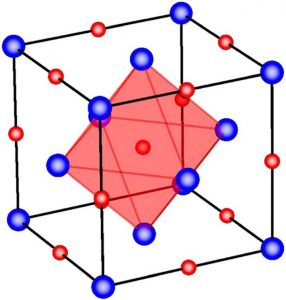
An international collaboration involving the CNBC serendipitously finds molecular “ball on a spring” while doing research for nuclear energy.
Source: Canadian Neutron Beam Centre (CNBC)
Contact: cnbc@cnl.ca
Image: physics-animations.com
Working with a team of researchers from Oak Ridge National Laboratory, Bill Buyers, a guest researcher at the CNBC, found a nearly ideal example of a molecular “ball on a spring,” a theoretical model studied by university physics students everywhere. The model has been useful to illustrate fundamental concepts, but no one had expected to find a real system in nature that matched the model with extreme precision.

Nitrogen atoms (red) caged by much larger uranium atoms (blue)
behave like a ball on a spring.
The team examined a crystal of uranium nitride, in which nitrogen atoms are trapped inside an octahedral-shaped cage of uranium atoms. Because the uranium atoms are so much heavier, they act like immovable objects to which the lighter nitrogen atoms are tethered.
The team was using neutron scattering to study magnetism in this material, in part because it is being considered as a fuel for more advanced nuclear power reactors; therefore, its properties needed to be fully understood.
The neutron data produced a series of distinct and evenly spaced oscillations that reflected the vibrational modes of the system. The researchers were astonished to realise that the oscillations matched the modes expected for a single-atom, isotropic quantum harmonic oscillator, which is one of the fundamental, exactly solvable problems in quantum mechanics.
This surprising result has practical implications for the nuclear industry, because these oscillations must be accounted for in computer simulations of nuclear power reactors that would use uranium nitride as a fuel.
